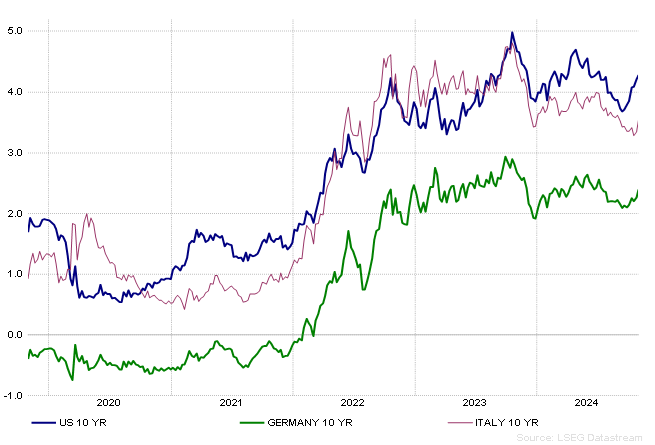The US economy grew solidly in the third quarter, with private consumption increasing at its fastest pace in 18 months and inflation slowing sharply. Annualized GDP growth for the third quarter was 2.8%. Investment bank Goldman Sachs lowered its projected probability of the country slipping into recession over the next 12 months by five percentage points to 15% following a better-than-expected jobs report: 254,000 new jobs were created in August and unemployment fell to 4.1%.
New figures published on November 1 were a setback, however, as only 12,000 new jobs were created. This is believed to have been a result of Hurricane Helene, which struck in early October, and the strike at aircraft manufacturer Boeing.
Capital markets anticipated and prepared for Donald Trump’s victory. According to polls, the candidates are neck and neck. It is estimated that Trump’s tax and spending plans would create more than twice as much new debt as those of Vice President Kamala Harris. The VP’s plans would add USD 3.5 trillion to the federal deficit over 10 years, while Trump’s would increase the deficit by USD 7.5 trillion. Trump is also expected to raise import tariffs. The fixed-income markets reacted negatively to the debt outlook, with the US 10-year rate rising from 3.80% to 4.28% in October.
In the equity markets, US technology companies continued to generate robust growth, but with the exception of chipmaker Nvidia, the impact on equity prices was subdued. Nvidia’s market capitalization again exceeded three trillion dollars, and the S&P 500 index reached an all-time high. Goldman Sachs’ projection of 3% average nominal growth for the S&P 500 index over the next ten years sparked considerable market debate. For October, the change in the value of the index was one percent in the negative.
Economic outlooks for China and Europe remain weak
In the third quarter, China’s economy grew at its slowest pace since the start of 2023. The economy grew by 4.6% in July–September, which was slightly more than forecast but slower than in the second quarter. Manufacturing grew for the first time in six months and services also picked up in October, reinforcing confidence that Beijing’s latest stimulus measures are helping to turn the economy around.
While the German economy is expected to stagnate this year, investors’ expectations improved more than expected in October, despite the difficulties experienced in the automotive sector. Car manufacturer Volkswagen plans to close three plants in Germany and lay off staff if it is unable to cut wage costs by 10%. The company reported that its sales in China have plummeted and its profits have fallen by more than 60% year-on-year. Despite Germany’s economic woes, the DAX index has been one of the best performing European markets since the end of June. The Stoxx Index fell 3.3% in October.
The ECB cut its key interest rates by 0.25 percentage points and anticipates that it will continue to ease monetary policy in December. Its Board members had to suppress fresh market optimism of higher interest rate movements, however. The euro area economy delivered a surprise in July-September with 0.4% growth on the previous quarter, up 0.9% on the previous year. Year-on-year growth was strongest in Spain, at 3.4%, and the French economy was boosted by the Olympics. Consumer price inflation in the euro area edged up to 2.0%, while core inflation remained unchanged at 2.7%.
Figure: long rates rose in October














